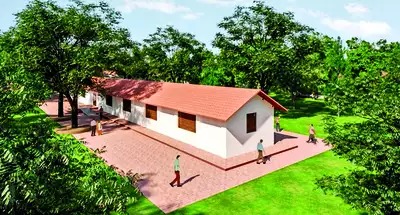The Sabarmati Riverfront Development Corporation Ltd (SRFDCL) has released a tender to restore a ‘gaushala’ or cow shelter, as part of the Rs 1,290 crore Gandhi Ashram Precinct Development Project in Ahmedabad, India. The gaushala is located beside the Sabarmati Gandhi Ashram and will be restored at an estimated cost of Rs 3.22 crore.
The design for the restoration of the gaushala is based on a 1948 aerial picture of the Ashram when it covered 19 hectares. The restoration aims to bring back the traditional architecture of the gaushala while providing modern amenities for the cows. The project is expected to be completed within the next two years.
The restored gaushala will feature open-air courtyards, a water treatment plant, and a biogas plant that will generate energy from cow dung. The open-air courtyards will provide a comfortable environment for the cows to graze and rest, while the water treatment plant will ensure that the cows have access to clean and safe water. The biogas plant is an innovative feature that will reduce waste and provide a sustainable source of energy.
Cows are considered sacred by many Hindus and play an important role in Indian culture and society. The restoration of the gaushala is an important project for India, as it will provide a safe and comfortable home for the cows, as well as help to preserve traditional architecture and promote sustainable practices.
According to a senior civic official, the gaushala was spread over 340 sq m on the southern side of the Ashram. New structures replaced the gaushala, but the area will now be cleared, and the gaushala will be restored to its original form as it was in 1948.
The project is part of the larger Gandhi Ashram Precinct Development Project, which aims to transform the area into a world-class heritage precinct. The development project will include the restoration of historic buildings, the creation of a riverfront promenade, and the development of gardens and public spaces.
Last week, the Ahmedabad Municipal Corporation (AMC) began clearing dwellings and illegal structures for the precinct development project. As far as civil works are concerned, landfilling work has been completed on several plots under the town planning scheme covering the project, according to an AMC official.
Currently, the area for visitors known as the ‘Gandhi Ashram’ is spread across 3 acres on which stands the ‘Hriday Kunj’, which was Mahatma Gandhi’s residence between 1917 and 1930. The complex also houses the museum designed by Charles Correa.
The restoration of the gaushala is an important step towards promoting sustainable practices in India, as well as preserving traditional architecture and culture. The project is expected to have a positive impact on the local community and the environment and serve as an example for similar projects in other parts of the country.
In conclusion, the restoration of the gaushala in Ahmedabad is a significant project that highlights the importance of preserving traditional architecture and promoting sustainable practices. The project is part of the larger Gandhi Ashram Precinct Development Project and is expected to be completed within the next two years. The restored gaushala will feature open-air courtyards, a water treatment plant, and a biogas plant that will generate energy from cow dung, providing a comfortable and sustainable home for the cows.

















